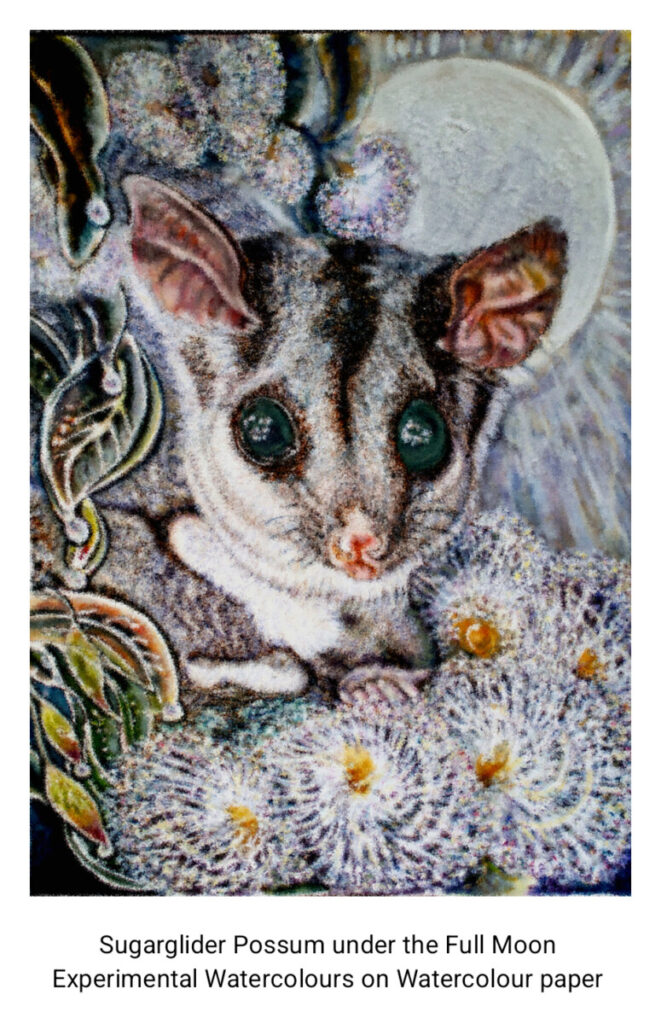Under the full luminous night of the full moon, tiny Sugar Glider Possums reach out from the safety of the interwoven branches of her familiar blossom laden tree…….
Leaving all known and familiar comforts behind…..preparing to leap out into the unknown of the night shimmering sky….…
and sail out through the star filled infinity.
All about Sugar Glider Possums
Learn about Sugarglider Possums at https://www.australianwildlife.org/wildlife/sugar-glider/

Sugarglider possums, scientifically known as Petaurus breviceps, are small, nocturnal marsupials native to Australia, New Guinea, and the surrounding islands.
These charming creatures are best known for their ability to glide through the trees, thanks to a unique membrane that stretches from their wrists to their ankles.
Habitat and Distribution
Sugar gliders thrive in a variety of forested environments, including eucalyptus forests, rainforests, and woodlands. Their geographical range extends across eastern and northern Australia and parts of New Guinea. According to Strahan (1995), these marsupials prefer habitats rich in flora that supports their dietary needs, particularly flowering trees that provide nectar and fruits.
Unique Adaptations
One of the most striking adaptations of sugar gliders is their gliding ability. The patagium, or the membrane that extends from their wrists to their ankles, enables them to glide up to 50 meters in a single leap (Martin et al., 2007). This adaptation is crucial for escaping predators and navigating their arboreal environment efficiently.
Additionally, sugar gliders have large, expressive eyes adapted for nocturnal vision, allowing them to forage at night. Their keen sense of smell helps them locate food sources, particularly in dense foliage where visibility is limited. These adaptations not only facilitate their survival but also contribute to their role as pollinators and seed dispersers in their ecosystems (Goldingay, 2000).
Diet and Feeding Behavior
Sugar gliders are omnivorous, with a diet primarily consisting of nectar, fruits, and insects. Their preference for nectar makes them important pollinators for various flowering plants. Research indicates that their feeding habits can significantly influence the reproductive success of certain tree species (Kinnaird & O’Brien, 2007)
They possess specialized gut bacteria that aid in the digestion of their varied diet, allowing them to extract the necessary nutrients from both plant and animal sources.
In captivity, sugar gliders require a balanced diet that mimics their natural intake.
This has led to the development of specific feeding guidelines to ensure their health and longevity, emphasizing the need for a varied diet rich in fruits and proteins (Woolley & Denny, 2018).
Social Structure and Behavior

Sugar gliders are social animals, often found in small family groups that include a breeding pair and their offspring. They communicate through a range of vocalizations, including chirps and barks, which facilitate social bonding and coordination during foraging. Social structures are essential for their survival, as they offer protection against predators and increase foraging efficiency (Jolly, 2000).
Interestingly, their social dynamics can be influenced by environmental factors such as habitat quality and food availability. In areas where resources are scarce, competition among groups may lead to changes in social behavior, including increased aggression (Kinnaird & O’Brien, 2007).
Conservation Status
Despite their adaptability, sugar gliders face threats from habitat loss, predation by introduced species, and climate change.
Deforestation for agriculture and urban development has significantly reduced their natural habitats, leading to population declines in some areas (Burbidge & McKenzie, 1989). Conservation efforts are critical to preserving their populations, including habitat restoration and the establishment of protected areas.
Public education and awareness campaigns are also vital in promoting coexistence with these unique marsupials. As sugar gliders become increasingly popular as pets, responsible ownership and breeding practices are essential to prevent overexploitation in the wild (Woolley & Denny, 2018).

Conclusion
Sugar glider possums are remarkable creatures that play a crucial role in their ecosystems. Their unique adaptations, social behaviors, and ecological significance underscore the need for conservation efforts to protect their habitats and ensure their survival. As we continue to study these fascinating marsupials, it becomes increasingly clear that understanding and preserving their natural environment is essential not only for their well-being but also for the health of the ecosystems they inhabit.
References
Burbidge, A. A., & McKenzie, N. L. (1989). Patterns in the modern decline of Western Australia’s vertebrate fauna. Western Australian Museum.
Goldingay, R. L. (2000). Ecology and conservation of the sugar glider in urban environments. Australian Mammalogy.
Jolly, A. (2000). The social structure of sugar gliders in the wild. Journal of Mammalogy.
Kinnaird, M. F., & O’Brien, T. G. (2007). The importance of sugar gliders in seed dispersal. Ecological Applications.
Martin, R., et al. (2007). Gliding mammals: Evolution and adaptation. Mammalian Biology.
Strahan, R. (1995). The Mammals of Australia. Australian Museum.
Woolley, L. A., & Denny, M. (2018). Captive care and management of sugar gliders. Australian Veterinary Journal.
